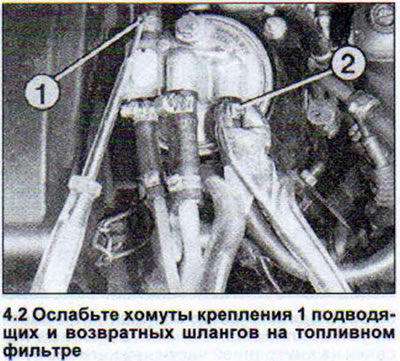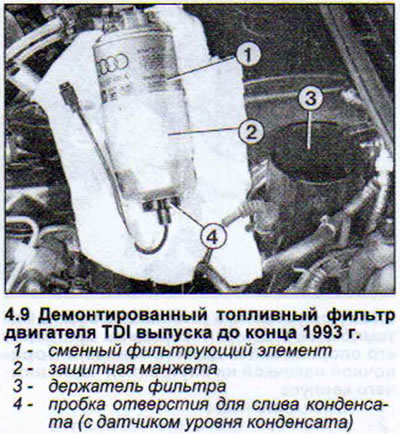Fuel filter for gasoline vehicles
The design of the fuel filter of AUDI 80 cars with a gasoline engine is such that it can not be changed throughout the entire life of the engine. This has its advantages, because in order to remove the fuel filter on quattro models, the fuel tank must also be removed. And this, in turn, is possible only after dismantling the rear axle. For this reason, we recommend changing the fuel filter only if necessary in the event of a malfunction in the fuel system.
Fuel filter for diesel vehicles
Distribution injection pump of diesel engines is very sensitive to fuel contamination, especially to water. As a rule, fuel contaminants clog the return hose connection and the injection pump overheats. Water enters the diesel fuel during refueling or accumulates as a result of its condensation. For this reason, the fuel must be cleaned of liquid and solid impurities before entering the injection pump. This function is performed by the fuel filter, the replaceable filter element of which traps all solid impurities, and condensate, which is heavier than fuel, is collected at the bottom of the filter.
TDI engines have a condensate level sensor located at the bottom of the filter instead of the condensate drain plug. This sensor works on a simple principle. Power is supplied above the two electric fuel filters. As soon as the level of condensate reaches the electrodes, the resistance in the circuit changes, which in turn is recognized by the control unit (see illustration 4.0b).

Condensate - drain
1. Remove the vent plug at the top of the filter.
2. Loosen the clamps of the inlet and return hoses on the fuel filter. The tie-down straps can be loosened with a small screwdriver to widen the lug. The same clamps can be reused by squeezing the eye with side cutters (see illustration). We recommend installing new clamping collars.

3. Loosen the filter nut (see illustration 4.10).
4. Pull the filter out of the holder by pulling upwards. For TDI engines, to do this, disconnect the plug of the condensate level sensor.
5. Place a condensate container under the fuel filter.
6. Remove the condensate drain plug at the bottom of the fuel filter by hand. Be careful. The screw plug is quite fragile. For TDI engines, instead of a plug, a condensate level sensor is screwed in.
7. Drain the condensate (it is approximately 100 cm3). Continue this procedure until clean fuel comes out of the drain hole.
8. Screw in the vent and drain plugs.
Fuel filter - replacement
9. TDI engines only. Disconnect the plug of the condensate level sensor and remove the plug from the mount (see illustration).

10. Loosen the clamps of the inlet and return hoses on the fuel filter and remove the hoses (see illustration).

11. Turn away a nut of fastening of the filter and remove the filter (see illustration 4.10).
12. Remove the protective foil from the fuel filter.
13. Disconnect the fuel filter from the mounting flange.
14. Drain the remaining fuel from the fuel filter into an appropriate container.
15. Install a new fuel filter.
16. TDI engines only. Screw the condensate level sensor into the new fuel filter.
17. Operate the starter until fuel begins to flow to the injection pump.
Attention! Do not dispose of the old fuel filter with household waste. It is recyclable.
Attention! If diesel fuel gets on the coolant hoses, the hoses should be cleaned immediately.
Instruction. There is a sieve in the intake cradle of the fuel gauge sensor. To clean it, the fuel gauge sensor must be removed.



Visitor comments